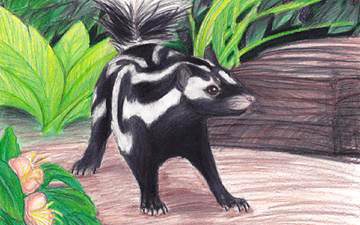The Eastern Spotted Skunk (Spilogale putorius) is a small, relatively slender skunk found throughout the eastern United States.
This small (16-23 inches) skunk is more weasel-like in body shape than the more familiar Striped Skunk. The Eastern Spotted Skunk’s stripes are broken in pattern, giving it a “spotted” appearance. They are found in the United States and northeastern Mexico, and are very small. They have a white spot on their forehead. They are much more active than any other type of skunk. They have mostly the same predators as any other skunk (big cats, bobcats, owls, humans, etc.). Up to eight skunks may share an underground den in the winter. They can also climb and take shelter in trees.
Eastern Spotted Skunks seem to prefer forest edges and upland prairie grasslands, especially where rock outcrops and shrub clumps are present. In western counties, it relies heavily on riparian corridors where woody shrubs and woodland edges are present. Woody fencerows, odd areas, and abandoned farm buildings are also important habitat for Eastern Spotted Skunks.
(From Wikipedia, June 11 2010)
– – –
Spotted skunks are smaller than Striped skunks and more weasel-like in appearance. Like all skunks, they have anal scent glands and can emit a foul-smelling spray to protect themselves. The Spotted Skunk usually sprays as a last resort, if stomping with its front paws or doing a handstand is not sufficient to warn off an intruder. Spotted Skunks are good climbers, able to scurry up and down trees like squirrels, and prefer forested areas to open countryside. They sometimes dig burrows to use for denning, and sometimes choose such places as barns, haystacks, dens abandoned by other mammals, or crevices in trees. Usually they live alone, although in cold weather, several skunks may den together.
(From Smithsonian’s North American Mammals via Encyclopedia of Life, June 11 2010)
– – –




